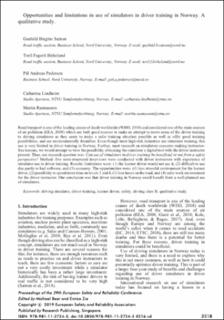| dc.contributor.author | Sætren, Gunhild Birgitte | |
| dc.contributor.author | Birkeland, Toril Fagerli | |
| dc.contributor.author | Pedersen, Pål Andreas | |
| dc.contributor.author | Lindheim, Catharina | |
| dc.contributor.author | Skogstad, Martin Rasmussen | |
| dc.date.accessioned | 2020-07-30T08:27:14Z | |
| dc.date.available | 2020-07-30T08:27:14Z | |
| dc.date.created | 2019-09-24T13:12:27Z | |
| dc.date.issued | 2019 | |
| dc.identifier.citation | Sætren, G. B., Birkeland, T. F., Pedersen, P. A., Lindheim, C. & Skogstad, Martin R. (2019). Opportunities and limitations in use of simulators in driver training in Norway. A qualitative study. In M. Beer & E. Zio (Eds.), Proceedings of the 29th European Safety and Reliability Conference (ESREL) (p. 3518-3524). Hannover: Germany. doi: | en_US |
| dc.identifier.isbn | 978-981-11-2724-3 | |
| dc.identifier.uri | https://hdl.handle.net/11250/2670455 | |
| dc.description.abstract | Road transport is one of the leading causes of death worldwide (WHO, 2018) and considered one of the main sources of air pollution (EEA, 2008) which are both good reasons to make an attempt to move some of the driver training to driving simulators as they seem to make a safer training situation possible as well as offer good training possibilities, and are environmentally friendlier. Even though most high-risk industries use simulator training, this use is very limited in driver training in Norway. Further, most research on simulators concerns making instructor-free lessons, we would attempt to view the possibility of making the simulator a digital tool with the driver instructor present. Thus, our research question was: Can use of simulators in driver training be beneficial or not from a safety perspective? Method: five semi-structured interviews were conducted with driver instructors with experience of simulator use in driver training. Results: limitations were: (1) the learner driver would not use it, (2) difficult to use due partly to bad software, and (3) economy. The opportunities were: (1) less stressful environment for the learner driver, (2) possibility to spend more time on levels 3 and 4, (3) less hours on the road, and (4) safer work environment for the driver instructor. Our conclusion was that driver training in Norway could benefit from a well-planned use of simulators | en_US |
| dc.language.iso | eng | en_US |
| dc.relation.ispartof | Proceedings of the 29th European Safety and Reliability Conference(ESREL). 22 – 26 September 2019 Hannover, Germany | |
| dc.relation.uri | http://itekcmsonline.com/rps2prod/esrel2019/e-proceedings/html/0216.xml | |
| dc.title | Opportunities and limitations in use of simulators in driver training in Norway. A qualitative study | en_US |
| dc.type | Chapter | en_US |
| dc.type | Peer reviewed | en_US |
| dc.description.version | publishedVersion | en_US |
| dc.subject.nsi | VDP::Teknologi: 500 | en_US |
| dc.source.pagenumber | 3518-3524 | en_US |
| dc.identifier.doi | 10.3850/978-981-11-2724-3_0216-cd | |
| dc.identifier.cristin | 1728316 | |
| dc.relation.project | The Research Council of Norway: 260524 | en_US |
